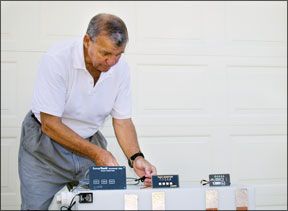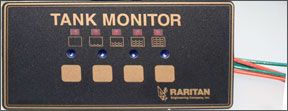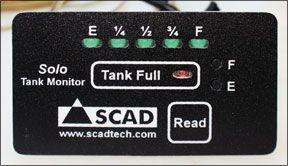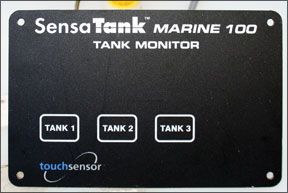
288
Knowing how full your holding tank is can mean more than simply having peace-of-mind. Whether you’re starting out on a Sunday daysail or a two-week inland cruise, one of your checklist items should always be “Check the tanks.” Unless you are far offshore, realizing the holding tank is full as you attempt to pump the head—or when you pick up the telltale odor from the overflow vent—can be a real problem.
Federal law mandates that all boats with permanent toilets have either an on-board treatment system or a holding tank to store wastewater. Many states with inland lakes and coastal areas have designated them as No Discharge Zones (NDZ) and require that the through-hull and Y-valve for direct discharge ports be sealed to prevent any discharge into the water.
From the freshwater supply to fuel and wastewater, knowing the level of all tanks is a must for comfortable and safe sailing. Several tank-monitor manufacturers now refer to three types of tanks: “fresh” for drinkable water, “gray” for drain water from sinks and showers, and “black” for wastewater holding tanks from toilets. State and federal regulations are changing to address these differences, but not all boats are plumbed with multiple tanks hooked to different through-hulls.
Most older and smaller boats do not have level gauges on any tanks. A good captain “just knew” about how full his tanks were or could judge the level by simply thumping the tank with his knuckles. Occasionally, if the tanks had inspection ports, a visual check with a flashlight or inserting a dipstick was sufficient.
Today, there are several options for measuring tank levels, starting with the simple internal float gauge and progressing to sophisticated ultrasonic capacitance or sonar internal probes. There also are various sensors designed to be mounted on the tank’s exterior, and those are our focus here. We’ll address sensors that are mounted internally in a future article.
What We Tested
Packaged kits containing externally mounted tank level sensors with remote reading displays are becoming increasingly popular due to the fact they don’t come into contact with the holding tank contents. Probes located inside the tank are more likely to be fouled, corrode, and need cleaning.
External sensors use basic capacitance sensors or the electronic Mirus detector cells that read liquid levels on the other side of plastic, polyethylene, and fiberglass tanks. External tank readers are for wastewater and fresh “sweet” water tanks, not aluminum or metal fuel tanks for diesel or gasoline. All of those we tested should work on standard tanks up to 3/8-inch thick, and all come with a one-year warranty.
When choosing a tank-level indicator, bear in mind that at least one side of the tank must be accessible for mounting the external sensor devices.

288
For this evaluation, Practical Sailor tested five external sensors with their mated display: Raritan Tank Monitor (1510012), Scad Profile Tank Monitor, SensaTank Marine 100, Snake River Acu-Gage Smart Mini, and Snake River Acu-Gage Three-Tank.
Raritan Tank Monitor
Raritan’s tank sensor works on 12-volt DC (other voltages are available). While it can display the liquid levels of four tanks, the kit comes with only two capacitance tank sensor modules. The kit also includes 10 feet of aluminum foil, a 3-amp fuse holder, 12 crimp splice connectors, and a display panel with screws and stick-on labels. These stickers—with universal symbols for “waste,” “gray,” and “fresh”—can be affixed to the display to identify the four buttons. PS testers questioned the durability of these stick-on labels.
The display panel is fairly small, measuring 2.25 inches high by 4.5 inches wide. It has four touch buttons for tank selection, and each has a corresponding hole for calibration. Five LED lights indicate the tank level: empty, quarter-full, half-full, three-quarters full, and full. Testers found these indicator lights to be dim and hard to see in daylight.
Raritan’s instructions are clear and well written—as long as you have a standard size tank. Tanks less than 7.5 inches tall or more than 20 inches tall require adjusting the amount of aluminum foil that is mounted to the side of the tanks.
Calibrating the Raritan is a simple a matter: fill a tank with water up to where you consider it full, then insert a small flat-head screwdriver into the hole above the selected tank’s touchbutton on the display panel, then turn it until all lights are on and then just the full light comes on. Repeat for each tank. The kit includes four small plastic plugs to insert in the holes once calibration is complete.
Before presstime, West Marine marked the Raritan’s Tank Monitor as a “clearance” item, discounting it to $224. Raritan plans this spring to release a new monitor, so stay tuned for its review in an update to this test.
Bottom Line: The Raritan unit provides standard tank monitor features with external capacitance sensors. We found its tech support and website to be lacking.
Scad Solo

288
The Scad Solo Profile Series (TM01) holding-tank monitoring kit includes a very small 2-inch-by-3.5-inch display panel, five feet of aluminum sensor foil, and one capacitance external tank sensor module. The display panel has a membrane-covered mechanical switch labeled “Read,” five prominent LED lights (that illuminate quite brightly) above each of which are labeled tank status levels (from empty to full) and a “Tank Full” red LED. It also has two tiny buttons (marked “F” and “E”) for calibrating functions.
Installation of the Scad Solo got off to a rough start due to its lengthy and unclear instruction manuals: a six-page booklet for the external non-contact fluid level sensor and a 10-page manual for the display panel. That seemed like a lot of reading for what should be a simple installation and hook-up. Upon digesting the instructions, testers found the manuals to be extremely wordy and not explicit enough. In fact, we had to call the manufacturer twice for clarification. Scad immediately e-mailed a new version of the instructions and offered verbal help.
Part of the confusion stems from the fact that Scad offers several versions of the display, and it can be programmed to work with many different types of tank sensor devices. The model we tested is intended for a holding tank. Scad also offers sensors specifically for water tanks as well as display panels that monitor up to eight tanks (Profile TM02).
In response to PS testers’ difficulty in translating the instructions, Scad said it is now overhauling the manual to make it shorter and more concise.
What the instructions lacked, the company makes up for in customer service. Technical support is available via phone seven days a week, 365 days a year.
Our initial problems aside, the installation and testing went smoothly. The Scad Solo Profile monitoring panel and external sensor have some unique and interesting features, including the ability to be calibrated for more accurate readings when using oddly shaped tanks that may be custom fitted. It also has the ability to program the characteristics of different types of tank sensors such as several internally mounted devices and the standard float sensors. Third, it allows you to program and set exactly where you want both the “empty” and “full” levels to be on your tank. Fourth, the external tank sensor module has a green LED indicator light that glows when the panel’s “Read” button is pushed, to indicate that all wiring is working. Finally, the Solo designed for holding tanks has a large red LED light on the panel, marked “Tank Full,” that will illuminate when the tank is 85 percent full. It reads the tank level every half-hour, so there may be about a 30-minute delay before the alarm goes off.
The Scad Solo will monitor only one tank, and the kit comes with one sensor and one display panel. To monitor two tanks, Scad suggests installing a rotary switch at the display panel, wiring it to sensors on the tanks and simply switching from one tank to the other as needed.
Bottom Line: Our favorite in the single-tank category, the Scad Solo kit was the most accurate, has more programming and calibrating flexibility, and will handle irregular-shaped tanks. We also like the tech support availability.
SensaTank Marine 100
The SensaTank Marine 100, made by TouchSensor Technologies and distributed by West Marine, says “Holding Tank Monitor” on the box but will work on freshwater tanks as well. This kit can monitor three tanks and contains three sets of fluid-level external tank sensors.
Each set has four proprietary stick-on “Mirus” field-effect detector cell sensors—one each for full, quarter-, half-, and three-quarters full—all pre-wired to a plug. This plug connects to the interface board presumably located near the tanks. The kit includes 20 feet of CAT-5 type cable and connectors to wire to the remote display panel. The 3.5-by-5.5-inch panel comes with screws and a plug for mounting and connection to 12-volt DC. The kit included an AMP male plug but did not include a female plug, and instructions suggested cutting off the plug to wire up to power. The panel has three field-effect touch-sensor buttons identifying “Tank 1,” “Tank 2,” and “Tank 3,” and an LED lighted bar graph that illuminates progressively to show the level of the selected tank when the corresponding button is pushed.

288
It comes with a very simple two-page instruction sheet with good diagrams. The installation is fast and straightforward with “plug-and-play” wiring that is obvious and intuitive with little chance of mistakes. No calibration is required. However, it would help if the detector cell sensors were marked: “full, ¾, ½, ¼.” (There is no “empty” sensor.) We accidentally stuck the quarter-full sensor near the bottom and the full sensor too close to the top. Once affixed, the sensors are very difficult to move.
Operating the monitor is very simple, and reading the level status is straightforward. Pressing and holding the button for the desired tank will illuminate LEDs behind cutouts that clearly show the liquid level. The SensaTank also has a visual alarm: If the tank liquid level reaches either below the quarter-full sensor or up to the full sensor, the indicator light flashes two times per second.
Bottom Line: SensaTank Marine 100, our top choice for the multi-tank monitor kits, comes with all necessary wire, connectors, and equipment, is easy to install, and simple to operate. The LED indicator lights are bright with easy-to-read labels, and the empty and full lights will flash when in alarm condition.
Acu-Gage Smart Mini
Another single tank monitoring kit, the Acu-Gage Smart Mini, manufactured by Snake River Electronics (now owned by Diamond Distribution), looks and functions almost identical to the Scad Solo.
The kit comes with a small display panel with stick-on ID stickers (“Fresh,” “Grey,” “Black,” “Waste,” and “Diesel”) for the single panel button, a holder for fuses and crimp connectors, a Moda capacitance sensor module, and five feet of aluminum sensor tape. The display panel includes five LEDs marked “Empty” through “Full,” tiny calibrating buttons, and a larger tank reading button. The 10-page instruction booklet was straightforward and well written—although like the Scad, it too had an incomplete wiring diagram.
While the Acu-Gage and Scad Solo look similar, their electronics and software are different. The Acu-Gage does not have an LED on the sensors, a “Tank Full” alarm/LED, or the ability to program different types of sensor or calibrate for odd-shaped tanks. The Acu-Gage monitors one tank.

288
Bottom Line: The Smart Mini is a no-frills kit that works well and is the least expensive, but it lacks extra features, and current availability through local marine distributors is lacking.
Acu-Gage three tank
We also tested Snake River’s three-tank monitoring kit. It has a larger monitor panel than the Smart Mini, but it calibrates and operates the same. It also has two additional tank push buttons.
Testers noted that accuracy was a bit off during testing, but Snake River suggested that adjusting the tape application slightly will alleviate this.
Bottom Line: This Snake River unit functioned without any problems, and it’s reasonably priced. We would like to see Snake River improve its tech support and presence in the marine retail market.
Conclusion
The quality and workmanship of all the display panels we tested appear to be good or better. The products are small enough to mount just about anywhere, and all draw minimal amperage.
The cost per tank monitored is difficult to determine since we tested both single- and multi-tank sensors. If you need to monitor two or more tanks, a multi-tank display makes sense and may even save you time and money. Each manufacturer represented offers additional tank sensors, and some offer other displays that allow for more tanks to be monitored.
Rating the sensors’ accuracy also was difficult, since each of the capacitance foil sensors read the tank water levels a little differently. When the tank was half full (visually measured), only one lit up half, while one showed one-quarter, and the others three-quarters full.
That being said, we decided against choosing a Best Choice and Budget Buy, and instead recommend the two standouts in this test: the Scad Solo single-tank monitor and the SensaTank 100 multi-tank monitor.
The feature-laden Scad was a top performer in accuracy with its main drawback being the instructions that are being revised, and the SensaTank was easy to install, accurate, and had good tech support.





































Thanks for sharing!
Here at Otodata, we design, develop, manufacture & sell precise data tank monitors, management software, & mobile app to businesses all over North America.